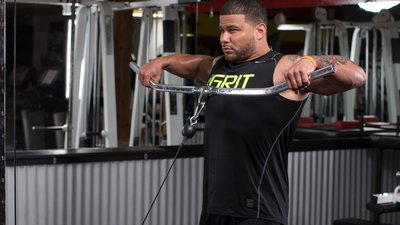Let's get a couple things clear right off the bat. First, when lifters talk about "building traps," they're usually talking about the upper traps, as opposed to the middle or lower traps. Those other portions often get lumped into upper-back training. This article is specifically focused on building that shirt-stretching yoke.
Secondly, there's no reason for me to go into detail about classic trap-building exercises like Olympic lifts, heavy deadlifts, and simple barbell or dumbbell shrugs. Suffice it to say, they all work.
This article is meant to provide you with some lesser-known, science-based, practical trap training techniques that you can use along with the staples in your programing to get more out of each workout.
1. Wide-Grip Barbell Shrugs
The general function of the upper trapezius is scapular upward rotation and elevation. So, loading those actions dynamically, like in all the exercises highlighted here, or isometrically like in a deadlift, is where the most bang for your buck is going to be found.
With this in mind, research has found that starting a shoulder shrug in 30 degrees of glenohumeral abduction—i.e., arms slightly out to the sides—generates greater upper-trapezius muscle activity in comparison to the shrug with the arms at the side.[1]
When translated to the gym floor, this means that performing barbell shrugs with something like a snatch grip may bring in just a little more upper trap than having your hands straight by your sides.
2. Single-Arm Angled Shrugs
You can apply the same concept of performing shrugs with your arms slightly outside your body to single-arm shrugs variations. These are great if you're trying to focus on one side, or are wanting to inject some variety into your training. Here are my three favorite single-arm shrug variations:
Low cable angled shrug: These are best for higher rep sets, like 12 reps or more per set, because you can only go so heavy without being pulled off your feet.
Leaning single-arm dumbbell shrug: These allow you to use heavier loads than low cable angled shrugs, which makes them a great option for lower rep sets. Plus, this exercise gives you isometric trap work on the side you're holding yourself up with. However, this can also be a limiting factor of this exercise because your grip doesn't get a chance to rest since both holding yourself up and holding the dumbbell demand grip work.
Leaning Gittleson shrug
The video demonstrates a tweaked version of a single-arm shrug I originally learned from strength coach Mike Gittleson, which is why I coined it the "Gittleson shrug." The only thing I've added to it is the slight side-lean, due to the research discussed in the previous section.
This is basically a seated version of the leaning single-arm dumbbell shrug. So, because you're holding on with the other arm, you're getting both isometric trap work and grip work on that side.
Also, because you're seated, you have a great base of support to use heavy loads if you'd like. Of course, you can also perform this and the standing version for higher reps sets just as easily.
3. Wide-Grip Upright Rows
Rowing exercises have long been recommended for strengthening the trapezius muscle, and the science backs up their effectiveness.[2,3] But more specifically, upright rows have been shown to activate the upper traps to a greater degree than horizontal rowing exercises such as bent-over rows.[4]
That said, when performing upright rows with a barbell or dumbbells, as I recommend in my book "Your Workout Perfected," you need to make some specific technique changes. First, use a relatively wide grip, and second, avoid pulling your elbows above shoulder height. Personally, I also find that using dumbbells instead of a barbell allows more freedom of movement.
Why these cues? A wider grip has been shown in studies to both increase deltoid and trapezius activity and reduce biceps brachii activity.[4]
In addition to maximizing recruitment of the muscle we're trying to develop, we need to also consider exercise safety, and specifically, shoulder safety. This is why you should avoid pulling the elbows above shoulder height.
Research indicates that impingement typically peaks between 70-120 degrees of glenohumeral elevation. Even if you're not someone with existing shoulder issues, keeping under 90 degrees, or shoulder height, is a good idea.[5,6]. In this case, don't listen to the full-ROM police.
4. Low Cable Angled (Wide-Grip) Upright Rows
This is a combination of the wide-grip strategy discussed above, and the upright row technique I just discussed. This variation allows you a bit more range of motion that you'll definitely feel in your upper traps, and some lifters who say that upright rows normally piss off their shoulders find they can actually tolerate these.
5. Full Range of Motion Shoulder Raises
Research shows that during scapular abduction (the scientific form for diagonally raising your hands up to a Y shape), upper trapezius activity differs throughout the range of motion. It increases from 0 (hands hanging by your side) to 60 degrees, then remains relatively constant from 6-120 degrees, and continues to progressively increase from 120-180 degrees, where your hands are straight overhead.[7]
It's for this reason that, in addition to doing more conventional upper-trap exercises, I recommend lifters who are looking to build their upper traps increase the range of motion on front and lateral shoulder raises.
In practical terms, this means going all the way above your head, and stopping when your wrists are directly above your shoulders, instead of stopping when your arms are parallel to the floor.
It's important to note that, when performing lateral shoulder raises, lift your arms in the scapular plane, at roughly a 30-degree angle to the torso, instead of out to the sides. Research shows that doing shoulder exercises in the plane of the scapula creates the same demands on the shoulder musculature, but reduces the unwanted stress on the rotator cuff tendon.[8,9] Work there, and you'll not only torch your lats, but also provide serious coactivation of the trapezius and serratus anterior.[10]
6. Dumbbell Trap-Blaster Complex
This puts together several elements we've discussed here along with some other trap-activating movements, like overhead shrugs and bent-over rows, to finish off your traps and shoulders. Pick a weight you can press for at least 10-15 smooth reps, because you're going to be holding onto that weight through at least four exercises!
Here's what it looks like:
Complex: 2-3 rounds without setting the weights down between exercises. Rest as needed between rounds.
- Dumbbell wide-grip upright row Up to 15 reps
- Dumbbell shoulder press Up to 15 reps
- Overhead shrugs Up to 15 reps
- Bent-over row Up to 15 reps
- Dumbbell shrug 15 reps, alternating 5 reps per side 3 times
References
- Pizzari, T., Wickham, J., Balster, S., Ganderton, C., & Watson, L. (2014). Modifying a shrug exercise can facilitate the upward rotator muscles of the scapula. Clinical Biomechanics, 29(2), 201-205.
- Hintermeister, R. A., Lange, G. W., Schultheis, J. M., Bey, M. J., & Hawkins, R. J. (1998). Electromyographic activity and applied load during shoulder rehabilitation exercises using elastic resistance. The American Journal of Sports Medicine, 26(2), 210-220.
- Moseley JR, J. B., Jobe, F. W., Pink, M., Perry, J., & Tibone, J. (1992). EMG analysis of the scapular muscles during a shoulder rehabilitation program. The American Journal of Sports Medicine, 20(2), 128-134.
- Handa, T., Kato, H., Hasegawa, S., Okada, J., & Kato, K. (2005). Comparative electromyographical investigation of the biceps brachii, latissimus dorsi, and trapezius muscles during five pull exercises. Japanese Journal of Physical Fitness and Sports Medicine, 54(2), 159-168.
- Schoenfeld, B., Kolber, M. J., & Haimes, J. E. (2011). The upright row: Implications for preventing subacromial impingement. Strength & Conditioning Journal, 33(5), 25-28.
- McAllister, M. J., Schilling, B. K., Hammond, K. G., Weiss, L. W., & Farney, T. M. (2013). Effect of grip width on electromyographic activity during the upright row. The Journal of Strength & Conditioning Research, 27(1), 181-187.
- Reinold, M. M., Escamilla, R., & Wilk, K. E. (2009). Current concepts in the scientific and clinical rationale behind exercises for glenohumeral and scapulothoracic musculature. Journal of Orthopaedic & Sports Physical Therapy, 39(2), 105-117.
- Johnston, T. B. (1937). The movements of the shoulder‐joint a plea for the use of the 'plane of the scapula' as the plane of reference for movements occurring at the humero‐scapular joint. BJS, 25(98), 252-260.
- Greenfield, B. (1994). Special considerations in shoulder exercises: plane of the scapula. The athlete’s shoulder. Churchill Livingstone, New York, 513-522.
- Ekstrom, R. A., Donatelli, R. A., & Soderberg, G. L. (2003). Surface electromyographic analysis of exercises for the trapezius and serratus anterior muscles. Journal of Orthopaedic & Sports Physical Therapy, 33(5), 247-258.

